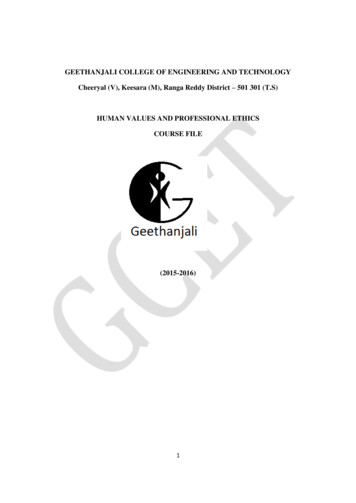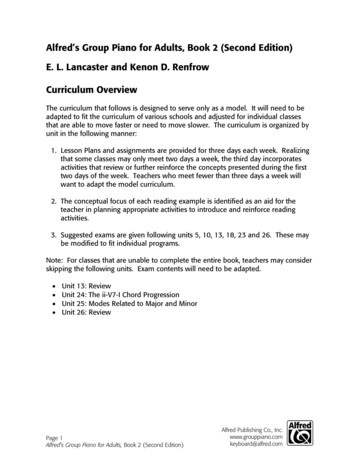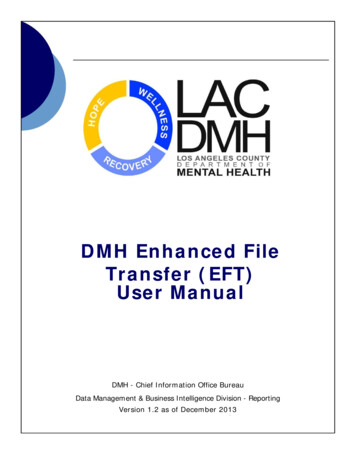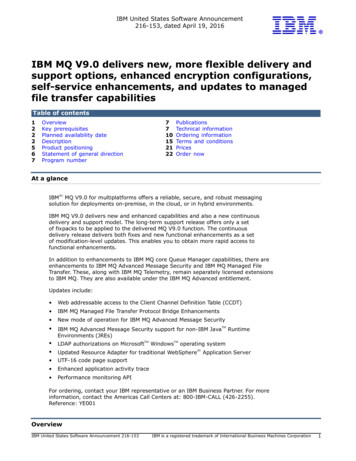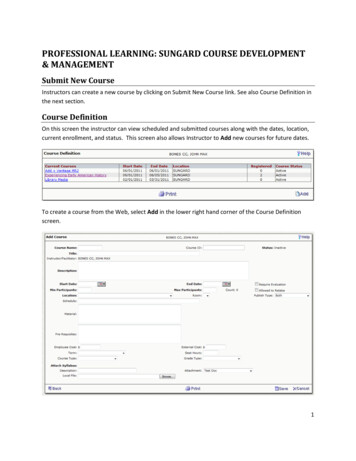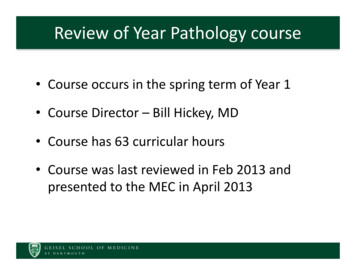
Transcription
SATELLITE COMMUNICATIONCOURSE FILE
ContentsCourse file Contents:1. Cover Page2. Syllabus copy3. Vision of the Department4. Mission of the Department5. PEOs and POs6. Course objectives and outcomes7. Instructional Learning Outcomes8. Prerequisites, if any9. Brief note on the importance of the course and how it fits into the curriculum10.Course mapping with PEOs and POs11.Class Time Table12.Individual Time Table13.Micro Plan with dates and closure report14.Detailed notes15.Additional topics16.University Question papers of previous years17.Question Bank18.Assignment topics19.Unit wise Quiz Questions20.Tutorial problems21.Known gaps ,if any22.References, Journals, websites and E-links23.Quality Control Sheets24.Student List25.Quality measurement sheetsa) Course end surveyb) Teaching evaluation26. Group-Wise students list for discussion topics
1. COVER PAGEGEETHANJALI COLLEGE OF ENGINEERING AND TECHNOLOGYDEPARTMENT OF Electronics and Communication Engineering(Name of the Subject / Lab Course) : Satellite Communications(JNTU CODE -)Programme : UGBranch: ECEVersion No : 02Year:Document Number: GCET/ECE//IVYear ECE (C )Semester: IINo. of pages :Classification status (Unrestricted / Restricted )Distribution List :Prepared by : 1) Name : MD TOUSEEF SUMER1) Name :2) Sign:2) Sign :3) Design :Asst.Prof3) Design :Date :: 11/11/13Verified by : 1)4)Name2) Sign4) Date* For: Q.C Only.:1) Name :3) Design :2) Sign4) Date3) Design ::4) DateApproved by : (HOD ) 1) Name : Dr.P,SRI HARI2) Sign:3) Date :::
2. SYLLABUSGEETHANJALI COLLEGE OF ENGINEERING & TECHNOLOGYCheeryal, Keesara (M), R.R.Dist.DEPARTMENT OF ECESYLLABUSJAWAHARLAL NEHRU TECHNOLOGICAL UNIVERSITY HYDERABADIV Year B.Tech. ECE. I-SemTPC4 1* 0 4SATELLITE COMMUNICATIONS(ELECTIVE – II)UNIT IINTRODUCTION [2] : Origin of Satellite Communications, Historical Back-ground, Basic Concepts ofSatellite Communications, Frequency allocations for Satellite Services, Applications, Future Trends ofSatellite Communications.UNIT IIORBITAL MECHANICS AND LAUNCHERS [1]: Orbital Mechanics, Look Angle determination,Orbital perturbations, Orbit determination, launches and launch vehicles, Orbital effects incommunication systems performance.UNIT IIISATELLITE SUBSYSTEMS[1] : Attitude and orbit control system, telemetry, tracking, Command andmonitoring, power systems, communication subsystems, Satellite antenna Equipment reliability andSpace qualification.UNIT IVSATELLITE LINK DESIGN [1] : Basic transmission theory, system noise temperature and G/T ratio,Design of down links, up link design, Design of satellite links for specified C/N, System design example.UNIT VMULTIPLE ACCESS [1][2] : Frequency division multiple access (FDMA) Intermodulation,Calculation of C/N. Time division Multiple Access (TDMA) Frame structure, Examples. SatelliteSwitched TDMA Onboard processing, DAMA, Code Division Multiple access (CDMA),Spread spectrumtransmission and reception.UNIT VI
EARTH STATION TECHNOLOGY [3]: Introduction, Transmitters, Receivers, Antennas, Trackingsystems, Terrestrial interface, Primary power test methods.UNIT VIILOW EARTH ORBIT AND GEO-STATIONARY SATELLITE SYSTEMS[1] : Orbitconsideration, coverage and frequency considerations, Delay & Throughput considerations, Systemconsiderations, Operational NGSO constellation DesignsUNIT VIIISATELLITE NAVIGATION & THE GLOBAL POSITIONING SYSTEM [1] : Radio and SatelliteNavigation, GPS Position Location principles, GPS Receivers and codes, Satellite signal acquisition,GPS Navigation Message, GPS signal levels, GPS receiver operation, GPS C/A code accuracy,Differential GPS.TEXT BOOKS:1. Satellite Communications– Timothy Pratt, Charles Bostian and Jeremy Allnutt, WSE, WileyPublications, 2nd Edition, 2003.2. Satellite Communications Engineering – Wilbur L. Pritchard, Robert A Nelson and HenriG.Suyderhoud, 2nd Edition, Pearson Publications, 2003.REFERENCES:1. Satellite Communications: Design Principles – M. Richharia, BS Publications, 2nd Edition, 2003.2. Satellite Communication - D.C Agarwal, Khanna Publications, 5th Ed.3. Fundamentals of Satellite Communications – K.N. Raja Rao, PHI, 20044. Satellite Communications – Dennis Roddy, McGraw Hill, 2nd Edition, 1996.3.VISION OF THE DEPARTMENTTo impart quality technical education in Electronics and Communication Engineeringemphasizing analysis, design/synthesis and evaluation of hardware/embedded software using variousElectronic Design Automation (EDA) tools with accent on creativity, innovation and research therebyproducing competent engineers who can meet global challenges with societal commitment.
3. MISSION OF THE DEPARTMENTi. To impart quality education in fundamentals of basic sciences, mathematics, electronics andcommunication engineering through innovative teaching-learning processes.ii. To facilitate Graduates define, design, and solve engineering problems in the field of Electronics andCommunication Engineering using various Electronic Design Automation (EDA) tools.iii. To encourage research culture among faculty and students thereby facilitating them to be creative andinnovative through constant interaction with R & D organizations and Industry.iv. To inculcate teamwork, imbibe leadership qualities, professional ethics and social responsibilities instudents and faculty.4. PEOS AND POSProgram Educational Objectives of B. Tech (ECE) Program :I.To prepare students with excellent comprehension of basic sciences, mathematics and engineeringsubjects facilitating them to gain employment or pursue postgraduate studies with an appreciationfor lifelong learning.II.To train students with problem solving capabilities such as analysis and design with adequatepractical skills wherein they demonstrate creativity and innovation that would enable them todevelop state of the art equipment and technologies of multidisciplinary nature for societaldevelopment.III.To inculcate positive attitude, professional ethics, effective communication and interpersonalskills which would facilitate them to succeed in the chosen profession exhibiting creativity andinnovation through research and development both as team member and as well as leader.Program Outcomes of B.Tech ECE Program:
1. An ability to apply knowledge of Mathematics, Science, and Engineering to solve complexengineering problems of Electronics and Communication Engineering systems.2. An ability to model, simulate and design Electronics and Communication Engineering systems,conduct experiments, as well as analyze and interpret data and prepare a report with conclusions.3. An ability to design an Electronics and Communication Engineering system, component, orprocess to meet desired needs within the realistic constraints such as economic, environmental,social, political, ethical, health and safety, manufacturability and sustainability.4. An ability to function on multidisciplinary teams involving interpersonal skills.5. An ability to identify, formulate and solve engineering problems of multidisciplinary nature.6. An understanding of professional and ethical responsibilities involved in the practice ofElectronics and Communication Engineering profession.7. An ability to communicate effectively with a range of audience on complex engineering problemsof multidisciplinary nature both in oral and written form.8. The broad education necessary to understand the impact of engineering solutions in a global,economic, environmental and societal context.9. Recognition of the need for, and an ability to engage in life-long learning and acquire thecapability for the same.10.A knowledge of contemporary issues involved in the practice of Electronics and CommunicationEngineering profession11.An ability to use the techniques, skills and modern engineering tools necessary for engineeringpractice.12.An ability to use modern Electronic Design Automation (EDA) tools, software and electronicequipment to analyze, synthesize and evaluate Electronics and Communication Engineeringsystems for multidisciplinary tasks.13.Apply engineering and project management principles to one's own work and also to manageprojects of multidisciplinary nature.5. Course objectives and outcomesCourse objectives:
This course will introduce the basic concepts and techniques of Satellite communication andfrequency allocations. By the end of the course, you be familiar with the most important methodsin satellite launchingThe course emphasizes intuitive understanding and practical implementations of the theoreticalconcepts.To produce graduates who understand how to analyze and manipulate digital signals and todetermine the orbital issues to have the fundamental knowledge to do so, for navigation andGPSCourse outcomes:CO 1: Able to obtain different types of satellitesCO 2: Ability to calculate the orbital determination and launching methodsCO 3: Ability to develop commads, monitoring power systems and developments of antennas.CO 4: Able to calculate multiple access techniques like TDMA, CDMA,FDMA,DAMA.CO 5: Able to design antennas to provide Uplink and Down link Frequency.CO 6: Able to design Satellite for real time applications.CO 7: Ability to design different kinds of transmitter and receiver antennas.CO 8: Ability to demonstrate the impacts of GPS, Navigation, NGSO constellation design for trackingand launching7. BRIEF NOTE ON THE IMPORTANTANCE OF THE COURSE AND HOW IT FITS IN TOTHE CURRICULAMSatellite communication is concerned with the representation, transformation of signals from earth stationto space. After half a century advances, satellite communication has become an important field, and haspenetrated a wide range of application systems, such as consumer electronics, digital communications,medical imaging, telecommunication, launching and so on. With the dramatic increase of the processingcapability of signal processing, it is the expectation that the importance and role of sc is to accelerate andexpand.8. PREREQUISITES, IF ANY
Types of satellites GPS Signals and GNNS9. INSTRUCTIONAL LEARNING OUTCOMESUNIT-I (INTRODUCTION)1) Students can understand the concept of Satellites.2) Analyze and implement digital signal processing systems in satellite launching3) They can understand Frequency r epresentation They can understand the practical purpose ofstability and causality for launching4) Able to know the applications.UNIT-II1. Students can able to define [1]: orbital mechanics and launchers2. Students may able to find Look Angle3. Able to find Orbital perturbations and Orbit determination4. To study launches and launch vehicles5. To study Orbital effects in communication systems performanceUNIT-III1. Able to define satellite subsystems2. To study Altitude and orbit control system3. To know telemetry, tracking, Command and monitoring, power systems, communication subsystems,4.To study Satellite antenna Equipment reliability and Space qualificationUNIT-IV1.To study satellite link design2.Able to know Basic transmission theory, system noise temperature and G/T ratio,3.Ability to design of down links, up link design,4.To Design of satellite links for specified C/N,5.Ability to solve System design using example
UNIT-V1. To study multiple access2. Frequency division multiple access (FDMA) Intermodulation,3. To Calculate C/N.4. To study Time division Multiple Access (TDMA) Frame structure5 Ability to differentiate Satellite Switched TDMA Onboard processing, DAMA, Code Division Multipleaccess (CDMA), Spread spectrum transmission and receptionUNIT-VI1. Able to know earth station technology2. Ability to identify Transmitters, Receivers, Antennas, Tracking systems, Terrestrial interface3. To calculate Primary power test methods.UNIT-VII1. To know about low earth orbit and geo-stationary satellite systems2. To define Orbit consideration, coverage and frequency considerations, Delay & Throughputconsiderations, System considerations,3. To Operate NGSO constellation DesignsUNIT-VIII1. To define satellite navigation & the global positioning system2. To define Radio and Satellite Navigation, GPS Position Location principles,3. To define GPS Receivers and codes, Satellite signal acquisition,4. To define GPS Navigation Message, GPS signal levels, GPS receiver operation,5. To define GPS C/A code accuracy and Differential GPS.10.Course mapping with Programme Outcomes:
Mapping of Course outcomes with Programme outcomes:*When the course outcome weightage is 40%, it will be given as moderately correlated (1).*When the course outcome weightage is 40%, it will be given as strongly correlated(2).POsSatelliteCommunicationCO 1: : Able to obtain1 2232452678291011212222222222222213different types ofsatellitesCO 2: : Ability tocalculate the orbitaldetermination andlaunching methodsCO 3: Ability to develop22commads, monitoringpower systems anddevelopments ofantennas.CO 4:. : Able to2calculate multipleTDMA,CDMA,FDMA,DAMA.CO 5 Able to design212222212222antennas to provideUplink and Down linkFrequencyCO 6: Able to designSatellite communicationssaccess techniques like
Satellite for real timeapplicationsCO 7:. Ability to design2222222222different kinds oftransmitter and receiverantennasCO 8: : Ability todemonstrate theimpacts of GPS,Navigation, NGSOconstellation design fortracking and launching11. Class Time TableTo be attached12. Individual time TableName: Ms.M.Umarani ver: 1DayMon1w.e.f.: 29/12/13423Load:1845LUNCH67
TUEWEDTHURFRISAT13. LECTURE SCHEDULE WITH METHODOLOGY BEING USED/ ADOPTEDTopic to be covered in OnelectureRegular/Additional/MissingTeachingAids usedLCD/OHP/BBIntroduction to .TotalnumberofperiodsDate147UNIT 209IIRegularUNIT8Remarks
LCDBB/OHP/LCDBB/OHP/LCDBB/OHP/LCDBBOHP
HPRegularBB/OHP27UNIT larBB/OHPRegularBB/OHPAdditionalBB/OHP3435UNIT V32063637BB3940UNIT VI3808RegularBB/OHPRegularBB/OHPRegularBB/OHP
HPRegularBB/OHPMissingBB/OHP4950UNIT 6UNIT VIII5309
of the decimator is5960BB61BB626364MID TEST IIGUIDELINES:Distribution of periods: No. of classes required to cover JNTU syllabus: 46 No. of classes required to cover Additional topics: 02 No. of classes required to cover Assignment tests (for every 2 units 1 test) No. of classes required to cover tutorials: 08 No of classes required to solve University: 04 Question papers: 04Total periods: 04: 64 .INTRODUCTION TO THE SUBJECTIn the class, starting from the basic definitions of a satellite, we will work our way throughfrequency allocations enough to analyze a practical communication system in detail. Hands-onexamples and demonstration will be routinely used to close the gap between theory and practicefor real time applications. Attitude and orbit control system, telemetry, tracking, Command andmonitoring, power systems, communication subsystems, Satellite antenna Equipment reliabilityBasic transmission theory, system noise temperature and G/T ratio, Design of down links, up linkdesign, Design of satellite links for specified C/N. Frequency division multiple access (FDMA)Intermodulation, Calculation of C/N. Time division Multiple Access (TDMA) Frame structure,
of the decimator isExamples. Satellite Switched TDMA Onboard processing, DAMA, Code Division Multipleaccess (CDMA),Spread spectrum transmission and reception. Radio and Satellite Navigation,GPS Position Location principles, GPS Receivers and codes, Satellite signal acquisition, GPSNavigation Message, GPS signal levels, GPS receiver operation, GPS C/A code accuracy,Differential GPS.14. DETAILED NOTES:Hard copy attached15. ADDITIONAL TOPICSAdditional/missing topicsGNNSUNIT 1Origin of satelliteThe concept of using object in space to reflect signals for communication was proved by Naval ResearchLab in communication when it use the Moon to establish a very low data rate link between Washingtonand Hawaii very low data rate link between Washington and Hawaii in late 1940’s. Russian started theSpace age by successfully launching SPUTNIK the first artificial spacecraft to orbit the earth, Thistransmitted telemetry information for 21 days in Oct. 1957.The American followed by launching anexperimental satellite EXPLORER In 1958. In 1960 two satellite were deployed “Echo” & “Courier”In1963 first GSO “SyncomThe first commercial GSO (Intelsat & Molnya) in 1965 these provides video(Television) and voice (Telephone) For their audienceINTRODUCTIONSatellites are specifically made for telecommunication purpose. They are used for mobile applications such asCommunications to ships, vehicles, planes, hand-held terminals and for TV and radio broadcasting. They areresponsible for providing these services to an assigned region (area) on the earth. The power and bandwidthof these satellites depend upon the preferred size of the footprint, complexity of the traffic control protocol schemesand the cost of ground stations. A satellite works most efficiently when the transmissions areFocused with a desired area. When the area is focused, then the emissions don‟t go outside that designated area andthus minimizing the interference to the other systems. This leads more efficient spectrum usage.
of the decimator isSatellites antenna patterns play an important role and must be designed to best cover the designated geographicalarea (which is generally irregular in shape). Satellites should be designed by keeping in mind its usability for shortand long term effects throughout its life time. The earth station should be in a position to control the satellite if itdrifts from its orbit it is subjected to any kind of drag from the external forces. Satellites orbit around the earth.Depending on the application, these orbits can be circular or elliptical. Satellites in circular orbits always keep thesame distance to the earth’s surfaceAPPLICATIONS OF SATELLITES1) Weather Forecasting Certain satellites are specifically designed to monitor the climatic conditions of earth. Theycontinuously monitor the assigned areas of earth and predict the weather conditions of that region. This is done bytaking images of earth from the satellite. These images are transferred using assigned radio frequency to the earthstation. (Earth Station: it is a radio station located on the earth and used for relaying signals from satellites.) Thesesatellites are exceptionally useful in predicting disasters like hurricanes, and 4monitor the changes in the Earth'svegetation, sea state, ocean color, and ice fields.2) Radio and TV BroadcastThese dedicated satellites are responsible for making 100s of channels across the globe available for everyone. Theyare also responsible for broadcasting live matches, news, world-wide radio services. These satellites require a 30-40cm sized dish to make these channels available globally.3) Military SatellitesThese satellites are often used for gathering intelligence, as a communications satellite used for military purposes, oras a military weapon. A satellite by itself is neither military nor civil. It is the kind of payload it carries that enablesone to arrive at a decision regarding its military or civilian character.4) Navigation SatellitesThe system allows for precise localization world-wide, and with some additional techniques, the precision is in therange of some meters. Ships and aircraft rely on GPS as an addition to traditional navigation systems. Many vehiclescome with installed GPS receivers. This system is also used, e.g., for fleet management of trucks or for vehiclelocalization in case of theft.5) Global TelephoneOne of the first applications of satellites for communication was the establishment of international telephonebackbones. Instead of using cables it was sometimes faster to launch a new satellite. But, fiber optic cables are stillreplacing satellite communication across long distance as in fiber optic cable, light is used instead of radiofrequency, hence making the communication much faster (and of course, reducing the delay caused due to theamount of distance a signal needs to travel before reaching the destination.).Using satellites, to typically reach adistance approximately 10,000 kms away, the signal needs to travel almost 72,000 kms, that is, sending data fromground to satellite and (mostly) from satellite to another location on earth. This cause’s substantial amount of delayand this delay becomes more prominent for users during voice calls.1.3.6) Connecting Remote AreasDue to their geographical location many places all over the world do not have direct wired connection to thetelephone network or the internet (e.g., researchers on Antarctica) or because of the current state of the infrastructureof a country. Here the satellite 5provides a complete coverage and (generally) there is one satellite always presentacross a horizon.7) Global Mobile Communication
of the decimator isThe basic purpose of satellites for mobile communication is to extend the area of coverage. Cellular phone systems,such as AMPS and GSM (and their successors) do not cover all parts of a country. Areas that are not covered usuallyhave low population where it is too expensive to install a base station. With the integration of satellitecommunication, however, the mobile phone can switch to satellites offering world-wide connectivity to a customer.Satellites cover a certain area on the earth. This area is termed as a „footprint‟ of that satellite. Within the footprint,communication with that satellite is possible for mobile users. These users communicate using a Mobile-User-Link(MUL). The base-stations communicate with satellites using a Gateway-Link (GWL). Sometimes it becomesnecessary for satellite to create a communication link between users belonging to two different footprints. Here thesatellites send signals to each other and this is done using Inter-Satellite-Link (ISL).FREQUENCY ALLOCATION FOR SATELLITE1) Geostationary or geosynchronous earth orbit (GEO) GEO satellites are synchronous with respect to earth. Lookingfrom a fixed point from Earth, these satellites appear to be stationary. These satellites are placed in the space in sucha way that only three satellites are sufficient to provide connection throughout the surface of the Earth (that is; theirfootprint is covering almost 1/3rd of the Earth). The orbit of these satellites is circular. There are three conditionswhich lead to geostationary satellites. Lifetime expectancy of these satellites is 15 years. 1) The satellite should beplaced 37,786 kms (approximated to 36,000 kms) above the surface of the earth.2) These satellites must travel in the rotational speed of earth, and in the direction of motion of earth, that iseastward.3) The inclination of satellite with respect to earth must be 0Geostationary satellite in practical is termed asgeosynchronous as there are multiple factors which make these satellites shift from the ideal geostationary condition.71) Gravitational pull of sun and moon makes these satellites deviate from their orbit. Over the period of time, they gothrough a drag. (Earth‟ s gravitational force has no effect on these satellites due to their distance from the surface ofthe Earth.)2) These satellites experience the centrifugal force due to the rotation of Earth, making them deviate from their orbit.3) The non-circular shape of the earth leads to continuous adjustment of speed of satellite from the earth station.These satellites are used for TV and radio broadcast, weather forecast and also, these satellites are operating asbackbones for the telephone networks. Disadvantages of GEO: Northern or southern regions of the Earth (poles)have more problems receiving these satellites due to the low elevation above a latitude of 60 , i.e., larger antennasare needed in this case. Shading of the signals is seen in cities due to high buildings and the low elevation furtheraway from the equator limit transmission quality. The transmit power needed is relatively high which causesproblems for battery powered devices. These satellites cannot be used for small mobile phones. The biggest problemfor voice and also data communication is the high latency as without having any handovers, the signal has to at leasttravel 72,000 kms. Due to the large footprint, either frequencies cannot be reused or the GEO satellite needs specialantennas focusing on a smaller footprint. Transferring a GEO into orbit is very expensive.2) Low Earth Orbit (LEO) satellites: These satellites are placed 500-1500 kms above the surface of the earth. AsLEOs circulate on a lower orbit, hence they exhibit a much shorter period that is 95 to 120 minutes. LEO systems tryto ensure a high elevation for every spot on earth to provide a high quality communication link. Each LEO satellitewill only be visible from the earth for around ten minutes. Using advanced compression schemes, transmission ratesof about 2,400 bit/s can be enough for voice communication. LEOs even provide this bandwidth for mobile terminalswith Omni directional antennas using low transmit power in the range of 1W. The delay for packets delivered via aLEO is relatively low (approx 10 ms). The delay is comparable to long-distance wired connections (about 5–10 ms).Smaller footprints of LEOs allow for better frequency reuse, similar to the concepts used for cellular networks. LEOscan provide a much higher e used in remote sensing an providing mobile communicat levation in Polar Regions andso better global coverage.8These satellites are mainly ion services (due to lower latency).
of the decimator isDisadvantages: The biggest problem of the LEO concept is the need for many satellites if global coverage is to bereached. Several concepts involve 50–200 or even more satellites in orbit. The short time of visibility with a highelevation requires additional mechanisms for connection handover between different satellites. The high number ofsatellites combined with the fast movements resulting in a high complexity of the whole satellite system. One generalproblem of LEOs is the short lifetime of about five to eight years due to atmospheric drag and radiation from theinner Van Allen belt1. Assuming 48 satellites and a lifetime of eight years, a new satellite would be needed everytwo months. The low latency via a single LEO is only half of the story. Other factors are the need for routing of datapackets from satellite to if a user wants to communicate around the world. Due to the large footprint, a GEOtypically does not need this type of routing, as senders and receivers are most likely in the same footprint.3) Medium Earth Orbit (MEO) satellites:MEOs can be positioned somewhere between LEOs and GEOs, both in terms of their orbit and due to theiradvantages andDisadvantages. Using orbits around 10,000 km, the system only requires a dozen satellites which is more than aGEO system, but much less than a LEO system. These satellites move more slowly relative to the earth‟ s rotationallowing a simpler system design (satellite periods are about six hours). Depending on the inclination, a MEO cancover larger populations, so requiring fewer handovers.Disadvantages: Again, due to the larger distance to the earth, delay increases to about 70–80 ms. the satellites needhigher transmit power and special antennas for smaller footprints. The above three are the major three categories ofsatellites, apart from these, the satellites are also classified based on the following types of orbits:4) Sun- Synchronous Orbits satellites:These satellites rise and set with the sun. Their orbit is defined in such a way that they are always facing the sun andhence they never go through an eclipse. For these satellites, the surface illumination angle will be nearly the sameevery time.(Surface illumination angle: The illumination angle is the angle between the inward surface normal andthe direction 9of light. This means that the illumination angle of a certain point of the Earth's surface is zero if theSun is precisely overhead and that it is 90 degrees at sunset and at sunrise.)Special cases of the sun-synchronousorbit are the noon/midnight orbit, where the local mean solar time of passage for equatorial longitudes is aroundnoon or midnight, and the dawn/dusk orbit, where the local mean solar time of passage for equatorial longitudes isaround sunrise or sunset, so that the satellite rides the terminator between day and night.5) Hohmann Transfer Orbit:This is an intermediate orbit having a highly elliptical shape. It is used by GEO satellites to reach their finaldestination orbits. This orbit is connected to the LEO orbit at the point of perigee forming a tangent and is connectedto the GEO orbit at the point of apogee again forming a tangent.6) Prograde orbit:This orbit is with an inclination of less than 90 . Its direction is the same as the direction as the rotation of theprimary (planet).7) Retrograde orbit:This orbit is with an inclination of more than 90 . Its direction is counter to the direction of rotation of the planet.Only few satellites are launched into retrograde orbit because the quantity of fuel required to launch them is muchgreater than for a prograde orbit. This is because when the rocket starts out on the ground, it already has an eastwardcomponent of velocity equal to the rotational velocity of the planet at its launch latitude.8) Polar Orbits
of the decimator isThis orbit passes above or nearly above both poles (north and south pole) of the planet on each of its revolutions.Therefore it has an inclination of (or very close to) 90 degrees. These orbits are highly inclined in shape.FRE
Navigation, GPS Position Location principles, GPS Receivers and codes, Satellite signal acquisition, GPS Navigation Message, GPS signal levels, GPS receiver operation, GPS C/A code accuracy, Differential GPS. TEXT BOOKS: 1. Satellite Communications - Timothy Pratt, Charles Bostian and Jeremy Allnutt, WSE, Wiley Publications, 2nd Edition, 2003. 2.

